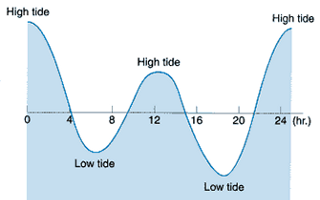Introduction
|
Tides are the periodic rise and fall of the water of oceans and seas caused mainly
by the gravitational interactions between the Earth, Moon and Sun.
At sea, the height of the tide is well under one meter but it increases considerable
in shallower coastal waters. The change of water level in some ports in the
North Sea exceeds ten meters. It is clear, that such a variation of
water depth must be taken into account while navigating on the shoreline.
|
Under normal conditions, tides rise and fall about every six hours.
Principally, high tide occurs at the Moon's transit over the local Meridian and
low tide is about six hours later.
Actual high tide occurs somewhat later, due to factors such as viscosity, friction,
geographical topology etc.
This time difference between the Moon's transit over the local Meridian and the
time high tide occurs is known as "lunitidal interval".
Eventually every location on the coastlines of the oceans and seas, will have not
only it's specific "lunitidal interval" but also it's specific "tidal curve" characterising
the transition from low to high tide and from high to low tide.
|

|
The gravitational interactions between the Earth, Moon and Sun on itself is
well predictable, but the "tidal curve" for a certain coastal location also strongly depends
on the geographical land-sea structure around this place. Since the early years of
naval activities, tidal prediction has been based more on heuristic techniques
than on mathematical models.
Today, tidal almanacs issued by the national hydrographic institutes and offices
- such as The Admiralty Tide Tables -
combine both methods to obtain reliable long-term predictions of navigable water
depths for thousands of coastal locations around the world.
|
